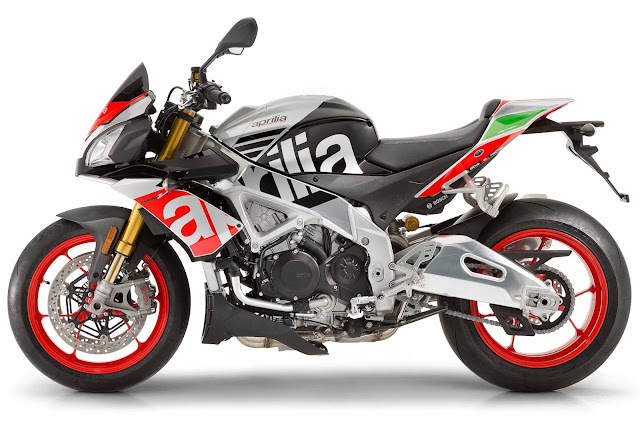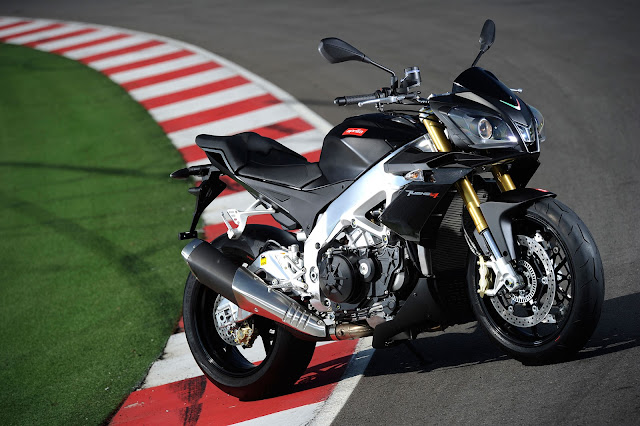Aprilia Tuono
The Tuono’s wide bars gave plenty of leverage, and its racy chassis meant the Aprilia handled as well as almost any sports bike.
Its lack of a fairing gave the Tuono a rather messy appearance, but plastic crash-protector bungs added a suitably streetwise touch.
Aprilia took a refreshingly direct approach when entering the naked sports bike division with the Tuono. The Italian firm followed the format of taking its top supersports bike, swapping clip-ons for high handlebars, and removing the fairing. Unlike other manufacturers, Aprilia didn’t detune the RSV Mille’s motor or invest in a fancy restyle.
Quite simply the Tuono was a stripped-down, high-barred version of the RSV, with all the performance and attitude that suggests. Aprilia’s no-nonsense approach meant that the Tuono - Thunder in Italian - wasn’t the prettiest of bikes, but the way it performed made up for that.
Like many of its breed, the Tuono wasn’t strictly a naked bike because it had a nose fairing, partly because Aprilia found the 998cc V-twin was too fast to be stable near its top speed while its rider was trying to grip the bars against the wind.
The 60-degree, liquid-cooled unit’s maximum power output was reduced very slightly, by 4bhp from the RSV, but this was hardly noticeable, and still left a very substantial peak of I26bhp.
The Mille’s rigid twin-spar aluminium frame was retained, wearing white plastic crash-protector mushrooms. Cycle parts were just like the RSV’s, too, which meant 43mm Showa upside-down forks, and a similarly multi-adjustable rear shock from German firm Boge. The nose fairing echoed the three-headlamp design of the original RSV Mille, giving a suitably aggressive look.
Straight-line performance was every bit as good as might have been expected of a bike with such a powerful engine and a total weight of just 403lb (183kg). Given a tweak of throttle the Tuono leapt forward almost regardless of revs, storming effortlessly towards a top speed of over I60mph (257km/h). There was a slight dip at about 6000rpm, but generally the V-twin unit felt very crisp and smooth, and its six-speed box was impressively slick.
The riding position was excellent, too. The pilot sat upright enough to be comfortable through town, or when following slow-moving traffic. But this Aprilia was not built to go slowly. With its nose fairing and fairly short screen keeping off some of the wind blast, it was almost impossible to resist the temptation to crack open the throttle and set the Tuono charging towards the horizon, its steering damper helping to prevent wobbles.
The suspension did a fair job of soaking up bumps while giving a firm and well-controlled ride. The slightly raised bars provided enough leverage to make changing direction easy, too, and the Tuono was very light and flickable. Brembo brakes gave plenty of stopping power.


It added up to a superb all-round sports bike, marred only a little by its slightly unfinished look, a tall seat that gave shorter riders a few problems, and a lack of comfort compared to most naked rivals. Those quibbles apart, the Aprilia had everything required from a sit-up-and-beg roadster. It was quick, handled superbly, was easy to ride, had heaps of attitude and was competitively priced. No surprise, then, that the Tuono soon carved itself a significant slice of the market.
Louder Thunder - the Tuono R
Aprilia followed an Italian industry trend by launching the Tuono not with the standard model - which was initially given the name Tuono Fighter - but with a limited-edition bike that became known as the Tuono R. Carbon-fibre and Kevlar bodywork combined with the gold-finished aluminium frame and swingarm to give a unique look. High-end Ohlins suspension, Brembo brakes and forged wheels also helped bump up the price, and the 998cc engine produced the full 130bhp of the RSV Mille.

Aprilia quickly sold the limited run of 200 machines, and later introduced a hotted-up model called the Tuono Factory, with similarly outrageous performance.

Aprilia quickly sold the limited run of 200 machines, and later introduced a hotted-up model called the Tuono Factory, with similarly outrageous performance.
Specification Aprilia Tuono
(2002)
(2002)
- Engine Liquid-cooled dohc eight-valve 60-degree V-twin
- Capacity 998cc (97 x 67.5mm)
- Maximum power 126bhp @ 9500rpm
- Transmission Six-speed, chain final drive
- Frame Aluminium twin spar
- Suspension Telescopic front; single shock rear
- Brakes Twin discs front; disc rear
- Weight 403lb (183kg)
- Top speed 165mph (265km/h)






















0 comments: